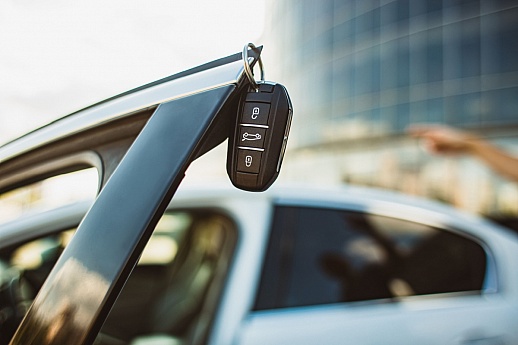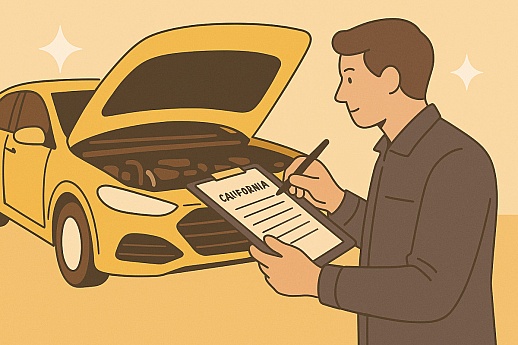Title-Holding vs. Non-Title-Holding States: What You Need to Know
You’ve just financed your dream car and all that’s left to do is sign the paperwork, and you’re ready to hit the road. But as you’re going through legalities, you encounter terms like “title-holding” vs. “non-title-holding.” What do they mean?
Drivers who finance their first car may be surprised to find out that the title doesn’t always transfer to you. Depending on your state, you may receive the title, or the lender might hold on to it – that’s what title-holding and non-title-holding refer to.
 In the following sections, we clarify the differences between title-holding vs. non-title-holding states, how they impact your financed car, and how to sell your car in the future.
In the following sections, we clarify the differences between title-holding vs. non-title-holding states, how they impact your financed car, and how to sell your car in the future.
What Is a Car Title?
Before we discuss the difference between title-holding and non-title-holding states, let's first define what a car title is. A car title is a legal document that proves ownership of a vehicle.
The information on a car title varies by state. But most contain the same general information:
- Vehicle Identification Number (VIN): This 17-digital number remains the same regardless of who owns the vehicle. It is used to track the vehicle's history, such as ownership, accidents, repairs, and maintenance.
- Make and Model Details: This includes the brand of the vehicle, like Toyota, and its name, like Yaris.
- Date of Manufacture: This includes the manufactured year and special engine or trim upgrades.
- Odometer Reading: This indicates how many miles were on the odometer when you purchased or sold the car. Most states require you to list the current mileage whenever there is a transfer of ownership.
- Assignment of Title: This lists the change of ownership and consists of two parts: one section that lists the seller’s name and one for the buyer.
- Lien Holder: If you are financing your car, the current lien holder, like the bank, credit union, or auto finance company, will be listed.
- Vehicle Weight Class: This relates to how much it will cost to register your car annually. Typically, the higher the weight class, the more it will cost to register.
What Are the Title-Holding States?
Having a car title is mandatory, as it serves as proof of ownership and is required to legally use a vehicle. Depending on the state you finance your car in, you may receive the title outright or the lender might hold on to the title until you pay off the balance.
In a title-holding state, the lender holds onto the vehicle title until you fully repay your loan. In these states, the lender is listed as the lienholder, while your name will be listed as the primary owner.
While you are still paying off the loan, you’ll receive a registration certification but not the title itself. Once the loan is paid in full, the lender will send you the title and a lien release letter. You will be responsible for taking these documents to the DMV to remove the lender as a lienholder from the title.
What Are the Non-Title-Holding States?
In non-title-holding states, the vehicle owner gets possession of the car title even if they haven't paid off their loan in full. When you buy a car with a loan in one of these states, you are listed as the primary title holder. The lender's name is also listed separately on the title as the lienholder, meaning they have a legal claim to the vehicle.
Once you pay off the loan, the lender provides you with a lien release document. You can then take the letter and the title to the DMV to take the lender off the title.
Title-Holding vs. Non-Title-Holding States
The main difference between title-holding vs. non-title-holding states depends on who the primary title holder is during the loan period. In title-holding states, the lender holds the title until the loan is repaid; in non-title-holding states, you hold the title.
Don't know where your state falls? Check out the list of title-holding states and non-title-holding states below:
Which States Are Title-Holding?
There are currently eight title-holding states:
- Maryland
- Michigan
- Minnesota
- Missouri
- Montana
- New York
- Oklahoma
- Wyoming
Which States Are Non-Title-Holding?
There are currently 42 non-title-holding states:
- Alabama
- Alaska
- Arizona
- Arkansas
- California
- Colorado
- Connecticut
- Delaware
- Florida
- Georgia
- Hawaii
- Idaho
- Illinois
- Indiana
- Iowa
- Kansas
- Kentucky
- Louisiana
- Maine
- Massachusetts
- Mississippi
- Nebraska
- Nevada
- New Hampshire
- New Jersey
- New Mexico
- North Carolina
- North Dakota
- Ohio
- Oregon
- Pennsylvania
- Rhode Island
- South Carolina
- South Dakota
- Tennessee
- Texas
- Utah
- Vermont
- Virginia
- Washington
- West Virginia
- Wisconsin
How to Sell a Car in a Title-Holding vs. Non-Title- States?
If you’re looking to sell your car, you’ll need to make sure you abide by your state’s regulations. This ensures the title is legally transferred to the buyer. When selling your car, there are two main considerations: whether your state is title-holding vs. non-title-holding and if your lien is paid off. Here’s what to do based on your situation:
Title-Holding States with an Outstanding Lien
If you still owe money on your car in a title-holding state, here are the steps to take to correctly sell your car:
- Contact your lender to determine the payoff amount and request a payoff letter.
- Inform potential buyers that there is an outstanding lien on the car.
- The buyer can either pay the outstanding lien amount directly to the lender or you, the seller. If the buyer pays you, ensure you send the payoff amount to the lender promptly.
- Once the lien is paid, the lender will issue a lien release document. Provide this document to the buyer.
- If the buyer paid the lender directly, the lender will transfer the title directly to the buyer. If you pay the lender, the title will be transferred to you. You must then endorse the title and complete the required sections to transfer ownership to the buyer. The buyer will then be responsible for taking the title to the DMV to register the car under their name.
Non-Title-Holding States with an Outstanding Lien
In non-title-holding states, the process is similar with a few minor differences:
- Determine the payoff amount and request a payoff letter from your lender.
- Inform potential buyers about the outstanding lien on the car.
- The buyer can pay the payoff amount directly to the lender or to you. If the buyer pays you, you will send the payoff amount to the lender.
- Once the lien is paid, the lender will issue a lien release document.
- Since you already have possession of the title in a non-title-holding state, you can automatically transfer the title to the buyer upon receiving the lien release document. This reduces the waiting period as you don’t need to wait for the lender to send the title.
Title-Holding States with the Lien Paid Off
If your lien is already paid off in a title-holding state:
- Verify that the lender has transferred the title to your name.
- Prepare the bill of sale and ensure both parties sign the title document.
- The buyer will be responsible for taking the signed title to the DMV to register the car under their name.
Non-Title-Holding States with the Lien Paid Off
The process in non-title-holding states is similar to title-holding states when the lien is paid off:
- Ensure you have the title and that it lists you as the primary owner.
- Prepare the bill of sale and ensure both parties sign the title document.
- The buyer will take the signed title to the DMV to register the car under their name.
Bottom Line
The main difference between title-holding and non-title-holding states is who holds the physical title document during the loan period. This distinction can significantly impact your responsibilities and the ease of managing your car ownership.
Being aware of your state's requirements helps you stay compliant with legal obligations, avoid potential issues, and ensure a smoother transaction when buying, selling, or refinancing your vehicle.
FAQ
This section addresses some frequently asked questions to help clarify the process of handling car titles.
What Should I Do if I Have Paid off My Loan but Haven’t Received the Title in a Title-Holding State?
Contact your lender to confirm that the loan is fully paid off and request a lien release letter. Then, take the lien release letter and other supporting documents to the DMV to obtain the title.
What Should I Do if There Are Errors on My Car Title?
If you notice any errors on your car title, contact your local DMV to correct them. You may need to provide supporting documents, such as the bill of sale or lien release letter, to verify the correct information.
Can I Sell My Car if I Lost the Original Title?
Yes, you can sell your car even if you have lost the title. You will need to request a duplicate title from your local DMV before completing the sale.
What Are the Consequences of Not Transferring a Car Title Properly?
Failing to transfer a car title promptly can lead to legal and financial complications, including fines, penalties, and difficulties in proving ownership or registering the vehicle.
What Are the Typical Fees Associated with Transferring a Car Title?
Title transfer fees vary by state. Generally, they range from $15 to $50 for the title application, $25 to $200 for registration, and any applicable taxes, usually around 5% to 10% of the vehicle’s value. Check with your local DMV for specific fee details.



